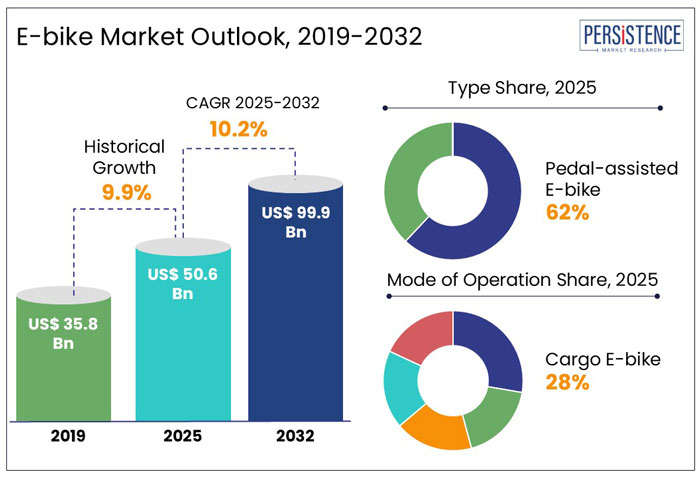Industry: Automotive & Transportation
Published Date: February-2025
Format: PPT*, PDF, EXCEL
Delivery Timelines: Contact Sales
Number of Pages: 185
Report ID: PMRREP18565
The global e-bike market is estimated to reach a size of US$ 50.6 Bn in 2025. It is predicted to rise at a CAGR of 10.2% through the assessment period to attain a value of US$ 99.9 Bn by 2032.
Consumers are considering electric bikes or e-bikes as the perfect alternative to scooters, personal vehicles, and public transport due to their compactness and ability to cover longer distances on a single charge. These bikes also offer good user experience with additional benefits, such as the non-requirement of driving licenses, insurance, inspections, and parking permits.
Demand for e-bikes is further set to flourish due to rising government norms revolving around environmental sustainability. Similarly, surging fuel prices due to geopolitical conflicts and rising taxes are anticipated to boost sales of e-bikes, especially in Europe and North America.

Key Highlights of the E-bike Market
|
Global Market Attributes |
Key Insights |
|
E-bike Market Size (2025E) |
US$ 50.6 Bn |
|
Market Value Forecast (2032F) |
US$ 99.9 Bn |
|
Projected Growth (CAGR 2025 to 2032) |
10.2% |
|
Historical Market Growth (CAGR 2019 to 2024) |
9.9% |
Investments in E-bike Charging Infrastructure Surged from 2019 to 2024 Amid Environmental Awareness
The global e-bike market recorded a CAGR of 9.9% in the historical period from 2019 to 2024. Rising technological developments and surging awareness of environmental issues augmented growth in the market during the historical period. For example,
North America and Europe quickly made progress. Innovations in battery technology, longer ranges, and improved charging infrastructure also boosted adoption. For instance,
Focus on Reducing Carbon Emissions to Surge Globally from 2025 to 2032
The connected e-bikes industry is anticipated to witness a CAGR of 10.2% through 2032. Growth is fueled by a desire for sustainable transport options and progress in battery innovations. E-bikes provide advantages like decreased carbon emissions, reduced operating expenses, and enhanced health benefits. The global market is on the rise, with increasing acceptance among diverse demographic groups. For example,
Government regulations are set to compel the adoption of e-bikes. Countries are likely to provide subsidies and incentives. Innovations in technology are estimated to bring better performance and longer battery life. For example,
Growth Drivers
Association of E-bikes with Enhanced Wellbeing to Spur Adoption Worldwide
E-bikes are not just environmentally friendly, they also offer substantial health benefits. For individuals with physical health challenges, e-bikes provide an accessible means of exercise and recreation.
Conditions that once restricted cycling, are now manageable with the assistance of e-bike motors. Research indicates that cycling enhances blood circulation to the brain, potentially reducing the risk of developing conditions like dementia in later life.
Consumers are focusing more on health and wellness. Hence, e-bikes can be marketed as low-impact alternatives to the traditional cycling experience. Also, by promoting physical activity, e-bikes contribute to improved cardiovascular health and well-being.
Ban on Private E-bike Sales due to Fire Safety Concerns May Hinder Demand
Regulatory and safety concerns pose significant restraints on the electric bike market size, as governments and organizations implement stringent measures to address fire hazards and quality standards. For instance,
Similar moves aim to mitigate risks associated with substandard batteries and chargers, reflecting broader regulatory efforts worldwide. These restrictions can limit market accessibility, increase compliance costs, and slow down throttle-controlled bike adoption among consumers.
Companies to Launch Battery Recycling Programs to Enhance Environmental Sustainability
The sustainability of battery-powered bikes presents a significant opportunity for market growth as consumers and governments prioritize eco-friendly transportation solutions. E-bikes produce zero tailpipe emissions, reduce traffic congestion, and offer an energy-efficient alternative to conventional vehicles. With increasing investments in renewable energy and carbon reduction goals, e-bikes align with global sustainability initiatives. For instance,
Several governments offer incentives, such as subsidies and tax benefits, to promote e-bike adoption. Additionally, developments in battery technology and recycling programs enhance their environmental benefits. As urban mobility shifts toward greener alternatives, demand for e-mobility bikes is anticipated to rise, augmenting innovation and market growth. For example,
A notable recent initiative in e-bike battery recycling is the industry-wide program launched in the U.S., powered by Call2Recycle and endorsed by PeopleForBikes. Since its inception, the program has collected and recycled around 85,000 pounds of e-bike batteries, demonstrating the industry's commitment to environmental stewardship.
Type Insights
Pedal-assisted E-bikes Gain Momentum with Ability to Improve Physical Fitness
In 2025, pedal-assisted e-bikes will likely account for 34.1% of the global e-bike market share. These are mainly used in urban setups as these can be easily navigated in traffic. Pedal-assisted e-bikes enable riders to cycle more frequently, making exercise enjoyable and easier. For example,
In these e-bikes, the motor is only to ease the peddling while human strength remains the main source that operates the e-bike. This helps improve cardiovascular health, build muscles, and increase endurance. Hence, pedal-assisted e-bikes are a popular option to boost physical fitness and wellness. According to Persistence Market Research (PMR), the pedal assisted e-bikes market is set to witness significant growth owing to its low price and more health benefits.
Mode of Operation Insights
Cargo E-bikes to be Highly Preferred due to Demand from Last Mile Delivery Companies
In 2025, the cargo e-bike segment is predicted to lead the e-bike market, accounting for 27.7% of the total share. Rise in e-commerce activities has spurred a need for efficient and green mobility in last-mile delivery solutions.
Cargo e-bikes are designed to carry luggage and goods with ease of traveling without the use of conventional fuels. These bikes are suitable for last-mile delivery services such as food delivery, grocery delivery, e-commerce deliveries, and postal deliveries. These e-cargo bikes can handle a weight of more than 200 kg, simultaneously reducing the carbon footprint during the delivery. For instance,

Europe to Witness Emergence of Subsidies and Packages to Lower Prices of E-bikes
Globally, Europe is projected to lead the demand for e-bikes, accounting for around 37.6% of the total market share in 2025. Growth is attributed to its strong support from governments followed by the rising popularity of e-bikes for mountain trekking activities. Countries like France, Spain, and Portugal have announced subsidies and packages to bring down the prices of e-bikes in their countries. For instance,
Companies in North America to Upgrade Existing Models with Sensors to Attract Customers
North America is anticipated to hold a 22.4% market share in 2025. New features such as longer battery life, sensors, and navigation displays have increased electric cargo bikes demand in the region. Manufacturers can incorporate these features in their existing models to differentiate their products, attract new customers, and augment market growth. For example,
North America is anticipated to witness a healthy CAGR of 10.6% from 2025 to 2032. Developments in motor design and integration enable firms in the region to deliver smooth rides and responsive assistance, enhancing electric-powered bike performance and comfort for users.
Ban on Motorcycle Use in Urban Areas to Reduce Pollution across Asia Pacific Boosts Demand
Asia Pacific e-bike market is set to witness steady growth due to rising urban planning activities in India and China. For instance,
Key players in the global e-bike market are implementing strategies to maintain and enhance their positions in the competitive landscape. With innovation being a leading factor, several companies are continuously developing new graphene batteries, which enable lightweight vehicles, fast charging time, and higher-capacity batteries.
To access a large consumer base and improve their supply chain and logistics operations, businesses are giving priority to efficient distribution channels and global growth. It is especially evident in emerging areas where there is a high demand for e-bikes.
Recent Industry Developments
|
Report Attributes |
Details |
|
Historical Data/Actuals |
2019 to 2024 |
|
Forecast Period |
2025 to 2032 |
|
Market Analysis Units |
Value: US$ Bn/Mn, Volume: As applicable |
|
Geographical Coverage |
|
|
Segmental Coverage |
|
|
Competitive Analysis |
|
|
Report Highlights |
|
|
Customization and Pricing |
Available upon request |
By Type
By Battery Type
By Motor Type
By Mode of Operation
By Region
To know more about delivery timeline for this report Contact Sales

The market is estimated to be valued at US$ 50.6 Bn in 2025.
The target market includes urban commuters, recreational cyclists, and environmentally conscious consumers.
In 2025, Europe is set to dominate the market with 37.6% share.
Yes, the e-bike business is set to reach US$ 99.9 Bn in 2032.
A few key players are Robert Bosch GmbH, Accell Group N.V, Giant Manufacturing Co., Ltd., Derby Cycle Holding GmbH, and Jiangsu Xinri E-Vehicle Co. Ltd.